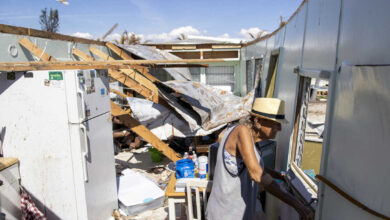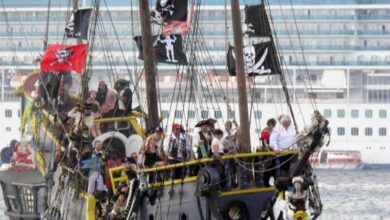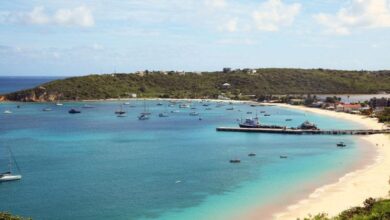
Alternative Realities in the Caribbean Exploring Visions
Alternative realities in the Caribbean: From imagined futures to utopian visions, this exploration delves into the diverse ways Caribbean societies have conceived alternative realities throughout history. We’ll journey through literature, art, music, and social movements to uncover how these visions have been shaped by colonialism, contemporary challenges, and the unique cultural tapestry of the region.
This journey through time and imagination will reveal how Caribbean people have used creativity and resilience to envision alternative paths for their societies, from the past to the present and into potential futures.
Historical Context of Alternative Realities
The Caribbean, a tapestry woven from diverse cultures and historical struggles, has always held within it a potent thread of alternative realities. These aren’t merely fantastical imaginings; they reflect the yearning for a better future, the resistance against oppressive systems, and the enduring spirit of resilience. The islands’ history, shaped by colonialism, slavery, and subsequent struggles for independence, has fueled a rich tradition of literature, art, and music that explores these alternative possibilities, offering glimpses into imagined utopias and critiques of the status quo.Caribbean societies have consistently sought to imagine alternative futures, drawing inspiration from various sources.
From the resistance movements that challenged colonial power structures to the burgeoning cultural expressions that blossomed in the face of adversity, the desire for a different reality has been a constant presence. These alternative visions often manifest as utopian ideals, glimpses of a more just and equitable world, or as critiques of the existing order.
Colonialism’s Impact on Alternative Realities
Colonialism fundamentally reshaped Caribbean societies, profoundly influencing their social structures, economic systems, and cultural landscapes. The imposition of foreign systems of governance and exploitation disrupted existing social structures and led to the creation of new forms of social organization. This disruption, in turn, fostered alternative realities that emerged in the form of resistance movements, religious practices, and cultural expressions.
The forced labor systems and the suppression of indigenous knowledge and traditions directly impacted the development of alternative social structures and spiritual beliefs.
Utopian Visions and Imagined Futures
The Caribbean has witnessed numerous instances of utopian visions and imagined futures, often embedded in literature, art, and music. These expressions offer compelling narratives of alternative social structures, free from the constraints of colonialism and its legacies. They represent a longing for a better world, a place where justice, equality, and prosperity prevail. For example, the works of writers like Aimé Césaire and Derek Walcott, through their poetry and prose, explored alternative realities, both in terms of imagining a post-colonial Caribbean and critiquing the enduring effects of colonialism.
Caribbean Literature, Art, and Music
Caribbean literature, art, and music have consistently served as powerful vehicles for exploring alternative realities. These artistic expressions reflect the struggles, aspirations, and resilience of Caribbean people. From the evocative rhythms of calypso and reggae to the vibrant colors and themes of Caribbean paintings and sculptures, these forms of expression offer a unique lens through which to examine the complexities of the Caribbean experience.
Works like “The Autobiography of Malcolm X” provide an insight into the experiences of individuals who sought to reshape the world around them.
Timeline of Significant Historical Events
- 1492: Arrival of Columbus, marking the beginning of European colonization and the disruption of indigenous societies. This event initiated a chain of events that profoundly impacted the region and shaped the narratives of alternative realities.
- 18th Century: The rise of resistance movements against slavery and colonial rule. These movements are significant because they represent early attempts to challenge the status quo and envision alternative realities, albeit within the constraints of the time.
- 19th Century: The development of national identities and cultural expressions. The emergence of these expressions demonstrates a yearning for a distinct identity that transcended the colonial influence and offered a glimpse of alternative social structures.
- 20th Century: The fight for independence and the emergence of post-colonial societies. This period marked a crucial turning point in the region’s history, leading to the creation of new nations and the pursuit of alternative social and political systems.
- Contemporary Era: The ongoing exploration of Caribbean identities and the struggle for social justice. This era showcases the continuous engagement with the complexities of the Caribbean experience and the development of alternative visions for the future.
Cultural Expressions of Alternative Realities
Caribbean folklore, mythology, and spiritual beliefs are rich tapestries woven with threads of alternative realities. These narratives, often passed down through generations, offer unique perspectives on the world, the supernatural, and the interconnectedness of human life with the environment. They provide a framework for understanding the complexities of the region’s history and the diverse experiences of its people.Caribbean cultures have developed profound and intricate systems of belief that go beyond the confines of the everyday.
These beliefs, embedded in art, music, and storytelling, create alternative realities that are deeply meaningful and significant to the region’s inhabitants. They are more than just stories; they are active forces shaping the way people experience their world, often intersecting with and influencing everyday life.
Folklore and Mythology Shaping Alternative Realities
Caribbean folklore and mythology are repositories of alternative realities. These narratives frequently feature spirits, deities, and magical creatures that inhabit parallel realms. Anansi, the trickster spider, for example, is a recurring character in numerous Caribbean traditions. His stories often explore themes of deceit, wisdom, and the complexities of human nature, offering an alternative perspective on morality and behaviour.
Other examples include the mythical creatures and spirits of the Haitian Vodou tradition, such as the lwa, which embody specific roles and influence various aspects of life. These characters and beliefs create alternative worlds, existing alongside and influencing the material world.
Music, Dance, and Storytelling in Shaping Alternative Perspectives
Music, dance, and storytelling are vital instruments in shaping alternative perspectives within Caribbean culture. Music, particularly calypso, reggae, and soca, often incorporates themes of social commentary, resistance, and spiritual beliefs, creating alternative realities through rhythmic expression. Dance forms like the conga and the limbo also embody alternative realities, through movement and expression, connecting the earthly and the spiritual.
Storytelling, whether through oral traditions or written narratives, allows for the transmission of cultural knowledge, values, and beliefs, thus shaping perceptions of the world and creating alternative realities.
Examples of Caribbean Artistic Expressions Embodying Alternative Realities
Numerous Caribbean artistic expressions embody alternative realities. The vibrant colours and symbolic imagery in Haitian vodou masks, for instance, create visual representations of the lwa, offering a glimpse into the spiritual realm. Caribbean literature, like the works of Nobel laureate Derek Walcott, often explores themes of identity, displacement, and the complexities of the human condition in relation to the supernatural.
These works, through their unique narratives and perspectives, create alternative realities.
Differences Across Caribbean Islands and Cultures
The cultural expressions of alternative realities vary significantly across the diverse islands and cultures of the Caribbean. The spiritual beliefs of Haiti, with its complex system of Vodou, differ from the folklore traditions of Jamaica, with its Anancy stories. Trinidad and Tobago’s calypso music, infused with social commentary, contrasts with the rhythms and narratives of reggae in Jamaica.
These differences reflect the unique histories, experiences, and interactions of the various groups within the region.
Comparison of Artistic Expressions
| Artistic Expression | Description | Example | Difference across Islands |
|---|---|---|---|
| Music | Musical forms expressing spiritual beliefs and social commentary. | Calypso, Reggae, Soca, Spiritual songs | Calypso (Trinidad) emphasizes social commentary, while Reggae (Jamaica) often explores spiritual themes and resistance. |
| Literature | Narratives exploring themes of identity, displacement, and the complexities of the human condition. | Novels, poems, short stories | Caribbean writers often use unique cultural perspectives to create alternative realities in their works. |
| Visual Arts | Art forms depicting spiritual figures, symbolic imagery, and magical creatures. | Masks, paintings, sculptures | Vodou masks (Haiti) depict specific lwa, contrasting with other island’s visual expressions. |
Alternative Realities in Contemporary Caribbean Society: Alternative Realities In The Caribbean
The Caribbean, a tapestry woven from diverse histories and cultures, is experiencing a vibrant resurgence of alternative realities. These realities are not simply a departure from the norm; they represent evolving social movements, new economic models, and innovative uses of technology, all intricately linked to the region’s unique challenges and opportunities. This dynamism reflects a conscious effort to redefine success, community, and identity in the face of global pressures.Contemporary Caribbean societies are witnessing a complex interplay of forces shaping alternative realities.
These forces are not isolated phenomena; they are interconnected and often mutually reinforcing, creating a dynamic and multifaceted landscape. Social movements are pushing boundaries, economies are diversifying, and technology is transforming how people interact and build community. This intricate interplay underscores the resilience and adaptability of Caribbean societies.
Contemporary Social Movements and Their Impact
Caribbean social movements are increasingly vocal and diverse, ranging from environmental activism to calls for social justice. These movements are not simply reacting to existing problems; they are proactively crafting alternative visions for the future. They often challenge established power structures and advocate for more equitable and sustainable systems. For instance, movements advocating for sustainable agriculture and community-based tourism are fostering alternative economic models that prioritize local knowledge and empowerment.
These movements highlight the importance of community participation in shaping development strategies.
Exploring alternative realities in the Caribbean often involves vivid imagery, but the practical realities of running a business there also demand attention. Keeping a tight rein on your office packaging and shipping supplies costs is crucial, just as it is anywhere. Learning how to effectively manage these expenses, like staying on top of your office packaging shipping supplies costs , can significantly impact your bottom line.
Ultimately, this practical focus ensures that creative visions in the Caribbean remain grounded in sound business practices.
Emerging Alternative Economies and Social Structures
The traditional Caribbean economy, heavily reliant on tourism and agriculture, is adapting. Emerging alternative economies are cropping up, based on sustainable practices and local resources. These include community-based tourism initiatives, cooperative farming projects, and the growth of micro-businesses. These alternative structures often prioritize community well-being, environmental sustainability, and economic empowerment of marginalized groups. For example, initiatives promoting agritourism offer a blend of recreation and sustainable food production.
This is transforming how Caribbean communities generate income and define prosperity.
Exploring alternative realities in the Caribbean often involves imagining vibrant economies and thriving communities. However, recent events, like the Air Jamaica CEO resignation prompting protests, air jamaica ceo resignation prompts protest , highlight the complex interplay of political and economic forces that shape the region’s realities. These disruptions, while sometimes unsettling, also reveal the potential for change and innovation in the face of challenges, ultimately offering new possibilities for the Caribbean’s future.
The Role of Technology in Shaping Alternative Realities
Technology is playing an increasingly significant role in shaping alternative realities in the Caribbean. Digital platforms are connecting communities, fostering dialogue, and enabling the sharing of knowledge and resources. Online communities are providing support networks for marginalized groups, facilitating the exchange of information and promoting social justice initiatives. Mobile technology, in particular, is empowering individuals and small businesses, offering access to new markets and opportunities.
This digital revolution is enabling the creation of virtual spaces where alternative social structures and economies can flourish.
The Intersection of Globalization and Alternative Realities
Globalization, while presenting challenges, also provides opportunities for the development of alternative realities. Caribbean societies are increasingly engaged in global networks, fostering collaborations and exchanges. This interconnectedness can lead to the dissemination of innovative ideas and practices. At the same time, the region is navigating the complexities of global trade and economic pressures, requiring alternative solutions that prioritize local needs and sustainability.
For example, the use of social media to promote Caribbean culture and tourism is a clear example of how globalization can be leveraged for the advancement of alternative realities.
Contrasting Social Movements and Their Visions
| Social Movement | Vision for the Future |
|---|---|
| Sustainable Agriculture Movement | A future where food security is ensured through locally-sourced, sustainable farming practices, reducing reliance on external imports and promoting community resilience. |
| Community-Based Tourism Movement | A future where tourism benefits local communities directly, creating economic opportunities, preserving cultural heritage, and minimizing environmental impact. |
| Environmental Activism Movement | A future where environmental sustainability is prioritized, mitigating climate change impacts and preserving biodiversity for present and future generations. |
| Social Justice Movement | A future where social inequalities are addressed, promoting inclusivity, equality, and empowerment of marginalized groups. |
Environmental and Ecological Alternative Realities

The Caribbean, a region steeped in vibrant culture and history, faces unprecedented environmental challenges. Rising sea levels, more frequent and intense storms, and changing rainfall patterns are reshaping the landscape and impacting the livelihoods of its people. Alternative realities in this context are not just abstract concepts; they represent tangible strategies for adaptation and resilience, recognizing the need for sustainable practices to ensure a viable future.
These alternative realities are crucial for preserving the unique ecosystems and cultural heritage of the region.The impacts of climate change are profoundly shaping alternative visions for the Caribbean. Rising temperatures, ocean acidification, and altered weather patterns are forcing a reevaluation of traditional practices and the development of new strategies for survival. From coastal communities facing inundation to agricultural sectors struggling with drought, the necessity for adaptation is clear.
This urgency has led to the exploration of alternative models of development that prioritize ecological sustainability.
Climate Change Impacts on Alternative Visions
The Caribbean’s unique geography and vulnerability to climate change necessitate the development of specific alternative visions. The region’s low-lying islands are particularly susceptible to sea-level rise, threatening coastal infrastructure and displacement. Alternative solutions must consider the need for robust coastal protection measures, as well as strategies for managing rising sea levels and associated saltwater intrusion. These solutions are not isolated from each other; they must be interconnected, addressing the broader ecological context.
Adapting agricultural practices to changing rainfall patterns is also crucial. Droughts and floods are becoming more frequent, requiring diversification in crops and water management techniques.
Ecological Approaches to Sustainability
Several ecological approaches to sustainability are gaining traction in the Caribbean. These approaches acknowledge the intricate connection between human activities and the environment. One critical approach focuses on ecosystem-based management, recognizing the interconnectedness of various ecosystems and the vital role they play in maintaining biodiversity and resilience. Another approach centers on the importance of local knowledge and traditional practices, recognizing the valuable insights and techniques passed down through generations.
These methods are particularly crucial in understanding and responding to specific environmental challenges in the Caribbean.
Sustainable Practices in the Caribbean
The Caribbean already demonstrates a rich tapestry of sustainable practices. For example, agroforestry systems, which combine agriculture with forestry, offer a sustainable alternative to traditional monoculture farming, improving soil health and biodiversity. Community-based fisheries management initiatives have proven effective in restoring fish stocks and ensuring the long-term viability of the fishing industry. These examples illustrate that sustainable solutions are not solely about large-scale interventions; they can also emerge from community-level initiatives.
Table: Ecological Challenges and Potential Solutions
| Ecological Challenge | Potential Alternative Solution |
|---|---|
| Sea-level rise and coastal erosion | Construction of seawalls, mangrove restoration, relocation of vulnerable communities, and implementation of sustainable coastal management plans. |
| Changing rainfall patterns and drought | Diversification of crops, rainwater harvesting, water conservation techniques, and drought-resistant agricultural practices. |
| Ocean acidification and coral bleaching | Reduced carbon emissions, protection and restoration of coral reefs, sustainable fishing practices, and promoting marine protected areas. |
| Deforestation and habitat loss | Reforestation initiatives, sustainable forestry practices, promoting agroforestry, and establishing protected areas. |
| Pollution (land and marine) | Waste management programs, promoting sustainable tourism practices, and enforcing environmental regulations. |
Alternative Realities in Caribbean Politics and Governance
The Caribbean, a region rich in history and culture, has witnessed a diverse array of political ideologies and governance models. From the legacy of colonialism to the complexities of post-independence struggles, the region has continually sought alternative paths towards self-determination and sustainable development. This exploration delves into the alternative political landscapes emerging in the Caribbean, examining the influence of resistance movements, the emergence of novel governance structures, and the opportunities and challenges inherent in these alternative approaches.The pursuit of alternative political realities in the Caribbean often stems from a desire to address the limitations of traditional models.
These limitations can manifest in economic disparities, social inequalities, and environmental vulnerabilities. Alternative political ideologies, therefore, often seek to prioritize the needs of marginalized communities, promote sustainable practices, and foster greater democratic participation.
Alternative Political Ideologies and their Influence
The Caribbean has witnessed a range of alternative political ideologies. These ideologies, drawing from various sources, including indigenous traditions, Pan-Africanism, and socialist principles, have often challenged the status quo and sought to empower marginalized groups. For example, Rastafarianism, while not a formal political ideology, has profoundly influenced social and political thought, advocating for self-reliance and spiritual liberation.
Exploring alternative realities in the Caribbean often involves more than just sun-drenched beaches. A recent $40 million investment in a rebirth at the Ritz-Carlton St Thomas, for example, ( a 40m investment buys a rebirth at Ritz-Carlton St Thomas ) showcases how these islands are constantly reinventing themselves. This significant upgrade highlights a fascinating shift in the Caribbean’s tourism landscape, offering a new perspective on how these destinations are evolving and attracting visitors.
The Role of Resistance Movements in Shaping Alternative Political Landscapes
Resistance movements, historically significant in the Caribbean, have played a crucial role in challenging oppressive structures and advocating for social justice. From anti-colonial struggles to contemporary movements advocating for environmental sustainability, resistance movements have often paved the way for alternative political landscapes. These movements, through activism, civil disobedience, and community organizing, have contributed significantly to the evolution of political discourse and the implementation of alternative governance models.
The Black Power movement, for example, significantly influenced the political consciousness and activism in the Caribbean.
Alternative Governance Models in the Caribbean
The Caribbean has seen experimentation with alternative governance models, often reflecting a desire for greater community participation and decision-making. These models range from participatory budgeting initiatives to community-based environmental management programs. These models often involve empowering local communities, fostering transparency, and promoting accountability in governance processes. The use of local knowledge and traditional practices in environmental management is an example of such an alternative approach.
Challenges and Opportunities for Implementing Alternative Political Approaches
Implementing alternative political approaches in the Caribbean faces numerous challenges. These challenges include the need for sustained political will, overcoming entrenched interests, and fostering collaboration across diverse communities. However, these challenges are not insurmountable. The opportunities inherent in these alternative approaches lie in the potential for greater social justice, economic equity, and environmental sustainability. The Caribbean’s rich cultural tapestry offers a wealth of knowledge and experiences that can be harnessed to develop and implement these alternative approaches.
Comparison of Political Systems and Potential Impacts
| Political System | Description | Potential Impacts (Positive) | Potential Impacts (Negative) |
|---|---|---|---|
| Community-Based Governance | Decision-making power devolved to local communities. | Enhanced local ownership, increased accountability, better responsiveness to local needs. | Potential for fragmentation, difficulties in coordinating across communities, potential for exclusion of certain groups. |
| Participatory Democracy | Citizen engagement in policy-making processes. | Increased citizen participation, enhanced legitimacy of policies, greater transparency. | Time-consuming processes, potential for gridlock, difficulties in reaching consensus. |
| Socialist Models | Emphasis on social welfare and economic equality. | Potential for reduced inequality, improved access to essential services, enhanced social cohesion. | Potential for bureaucratic inefficiencies, reduced economic incentives, potential for authoritarian tendencies. |
Imagining Future Scenarios in the Caribbean

The Caribbean, a vibrant tapestry of cultures and landscapes, faces a complex future shaped by internal dynamics and global trends. This exploration delves into potential alternative realities, from utopian visions of prosperity to dystopian scenarios of hardship, highlighting the crucial role of technology and innovation in shaping these futures. Understanding these possibilities is key to navigating the challenges and opportunities that lie ahead.The Caribbean’s future is not predetermined.
A range of scenarios, both positive and negative, is possible, depending on choices made today. These scenarios can be viewed as thought experiments, offering insights into potential pathways and the decisions that could lead to them. This allows for proactive planning and adaptation to navigate the uncertainties of the future.
Thinking about alternative realities in the Caribbean, it’s fascinating how the islands are evolving. The influx of tourists, facilitated by increased airlift and cruise ship options, is reshaping the region’s economy. This growth, as detailed in airlift and cruise ships help fuel caribbean growth , is leading to a vibrant mix of traditional and modern experiences. Ultimately, this economic shift creates unique and alternative realities for the Caribbean, offering new perspectives on island life.
Utopian and Dystopian Visions
The Caribbean’s future can manifest in diverse ways, ranging from harmonious coexistence to fractured realities. Utopian visions often portray a region embracing sustainable practices, technological advancements, and social equity, fostering a vibrant and prosperous society. Dystopian visions, on the other hand, depict a region grappling with environmental degradation, economic disparity, and political instability, resulting in a bleak and unequal future.
The Role of Technology and Innovation
Technology and innovation will play a significant role in shaping the future of the Caribbean. Advancements in renewable energy, communication technologies, and biotechnology can drive economic growth, enhance quality of life, and create opportunities for sustainable development. However, the uneven distribution of these technologies could exacerbate existing inequalities if not carefully managed. The integration of technology needs to be inclusive and equitable to avoid widening the gap between the haves and have-nots.
Impact of Global Trends
Global trends, such as climate change, economic globalization, and political shifts, will significantly impact the future of the Caribbean. Climate change poses a direct threat to island nations through rising sea levels and extreme weather events. Economic globalization presents opportunities for trade and investment but also challenges related to competition and dependency. Political shifts in major global players can affect the region’s political and economic stability.
Exploring alternative realities in the Caribbean often means discovering hidden gems and unique experiences. The recent opening of the Alohilani Waikiki Beach hotel, a stunning new addition to the area, alohilani waikiki beach makes its opening official , is a prime example of this. This new luxury hotel showcases a fresh perspective on hospitality, mirroring the vibrant and diverse spirit of alternative realities often found throughout the Caribbean islands.
Future Scenarios Table
| Scenario | Description | Positive Impacts | Negative Impacts |
|---|---|---|---|
| Sustainable Archipelago | Caribbean nations adopt sustainable practices, fostering a harmonious relationship with the environment. Renewable energy sources become dominant, and economies are diversified. | Reduced environmental impact, increased resilience to climate change, enhanced quality of life. | Potential for slower economic growth in the short term, requiring significant upfront investment. |
| Digital Divide | Uneven access to technology and digital literacy leads to a widening gap between the technologically advanced and those lagging behind. This results in limited opportunities for some communities. | Potential for increased efficiency and productivity in certain sectors. | Increased social inequalities, limited access to essential services, potential for job displacement. |
| Fragmented Federation | Political instability and economic disparities lead to the fracturing of the Caribbean region into smaller, often competing, entities. | Potential for localized solutions to regional problems. | Reduced economic scale and bargaining power, heightened security risks, and limited cooperation on pressing issues. |
| Resilient Islands | Caribbean nations develop robust strategies to adapt to climate change impacts, fostering resilience and sustainability. | Improved infrastructure, enhanced disaster preparedness, increased community cohesion. | Significant investment required, potential displacement of populations, and adaptation may not be sufficient for all regions. |
Alternative Realities and Identity
The Caribbean, a mosaic of cultures and histories, is a fertile ground for exploring alternative realities. These alternative visions, often interwoven with the struggles and aspirations of its people, deeply shape and are shaped by the identities of Caribbean communities. The complex interplay of colonialism, migration, and cultural exchange has created a unique and dynamic tapestry of identities, and the alternative realities imagined reflect these intricate threads.
Understanding how these realities are conceived by different communities offers crucial insights into the future trajectories of Caribbean societies.Caribbean identities are multifaceted and dynamic, constantly evolving in response to shifting socio-political landscapes. Cultural, social, and political factors intertwine to create the complex and nuanced identities found throughout the region. These factors include historical legacies of colonialism, enduring traditions, contemporary global influences, and the unique challenges and opportunities facing different communities.
Cultural Expressions of Alternative Identities
Caribbean cultures have a rich tradition of storytelling, music, and art that often embody alternative realities. These expressions are not simply reflections of the present; they are active agents of change, offering glimpses into possible futures. For example, in literature, the work of writers like Jean Rhys and Derek Walcott often explores the psychological and social impacts of colonialism and migration, highlighting the complexities of Caribbean identity in the face of adversity.
Music genres like reggae and calypso, with their social commentary and rhythmic energy, also provide a powerful platform for articulating alternative realities and challenging existing power structures.
Social Factors Shaping Alternative Realities
The social fabric of Caribbean societies is deeply affected by migration patterns, class divisions, and racial dynamics. These factors, in turn, shape the ways in which different communities conceive alternative realities. For instance, communities experiencing economic hardship may envision a future where resources are more equitably distributed, fostering a more just and prosperous society. Conversely, communities facing discrimination or marginalization might imagine alternative realities that address systemic inequalities and promote inclusivity.
The social conditions prevalent in each community are crucial in shaping their specific visions of the future.
Political Factors in Shaping Alternative Identities, Alternative realities in the caribbean
Caribbean politics plays a significant role in shaping alternative realities and identities. From the ongoing struggle for self-determination to the evolving dynamics of regional integration, political movements and policies often inspire alternative visions for the future. For example, the push for greater economic autonomy in the region reflects a desire for alternative economic models that prioritize local needs and development.
The pursuit of social justice and human rights is also reflected in alternative realities imagined by various groups, seeking a more equitable and inclusive future.
Hybridity and Alternative Identities
The concept of hybridity is central to understanding Caribbean identities. The blending of African, European, and Indigenous traditions, coupled with influences from other parts of the world, has created unique cultural expressions and alternative realities. This fusion is evident in the cuisine, music, and art forms of the region, where elements from different cultures are combined and transformed.
For example, the cuisine of Trinidad and Tobago reflects the blending of African, Indian, and European culinary traditions, creating a distinctive and vibrant culinary landscape. This hybridity isn’t simply about mixing elements; it is about creating something new, something unique, something that reflects the complexities of Caribbean identity.
Illustrative Examples of Imagined Futures
Different communities within the Caribbean have diverse conceptions of alternative realities. In rural communities, there might be a desire for sustainable development and a return to traditional agricultural practices, imagining a future rooted in local resources and knowledge. Urban communities, facing issues like unemployment and crime, might envision a future with improved access to education, employment opportunities, and community development initiatives.
These examples illustrate how the specific challenges and aspirations of each community shape their distinct visions for the future. The imagined futures range from practical solutions to more abstract, philosophical aspirations.
Closure
In conclusion, alternative realities in the Caribbean are a vibrant reflection of the region’s resilience, creativity, and enduring spirit. From historical echoes to contemporary movements, the Caribbean people have consistently imagined and explored alternative ways of being, highlighting the importance of cultural expressions, social movements, and environmental concerns in shaping their futures.
Questions and Answers
What role does technology play in shaping alternative realities in the Caribbean?
Technology is increasingly important in shaping alternative realities in the Caribbean. It’s used in new social movements, in creating alternative economies, and in imagining different futures, as seen in digital art and virtual communities.
How do environmental challenges influence alternative realities in the Caribbean?
Climate change and environmental degradation are major factors in how Caribbean people envision alternative realities. Sustainable practices and ecological approaches are central to many alternative visions for the future of the region.
What are some examples of alternative political ideologies in the Caribbean?
Alternative political ideologies in the Caribbean range from resistance movements to calls for self-determination. These movements often challenge existing political systems and offer different visions for governance.






